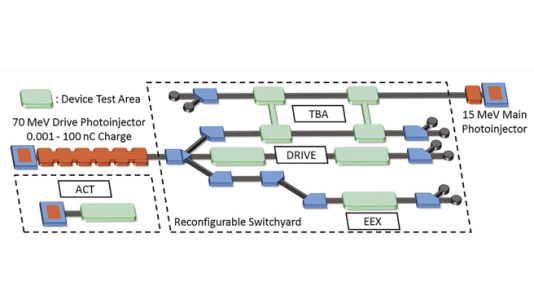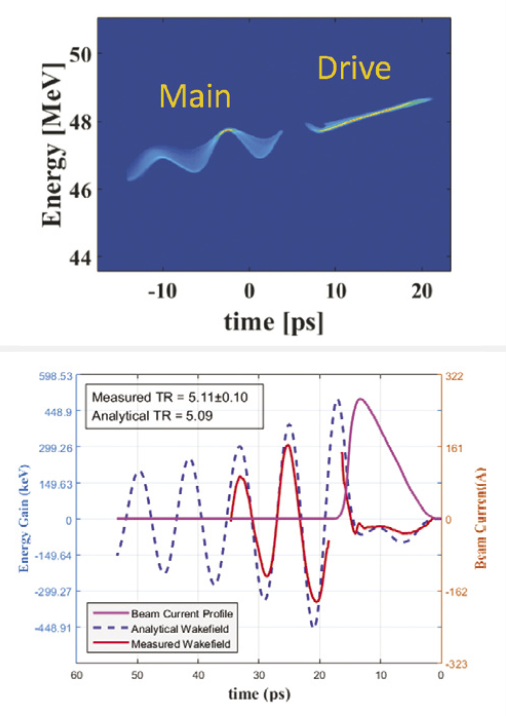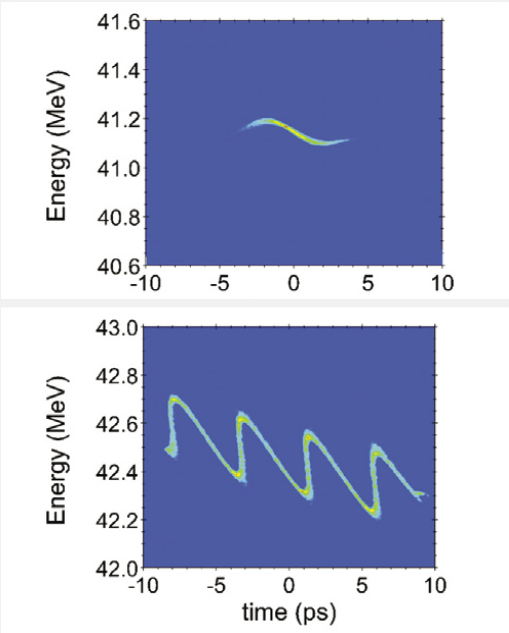
Scientists at the U.S. Department of Energy’s Argonne National Laboratory are working to develop advanced acceleration concepts (AAC) at the laboratory’s Argonne Wakefield Accelerator (AWA) facility [1]. In addition to the in-house AAC program carried out by the AWA group, the facility hosts more than 20 collaborators from around the world who come to use its state-of-the-art facility dedicated to the development of technology for future accelerator facilities. AWA’s resourceful group of six staff, two postdoctoral fellows and several graduate students (sent by collaborators) carry out its productive AAC R&D program.
As part of Argonne’s AAC studies, the laboratory seeks to explore and develop advanced acceleration techniques that are capable of operating at higher gradients and lower costs than today’s operating accelerator facilities. To pioneer these AAC techniques, Argonne researchers develop a host of AAC-supporting technologies including beam diagnostics, beam sources and beam dynamics, along with theory and simulations. By successfully developing these AAC technologies, Argonne hopes to lay the foundation for the next generation of large-scale accelerator facilities, such as a multi-TeV electron-positron collider or a fifthgeneration light source. In addition, these breakthroughs could yield spin-off technologies for compact accelerator applications, such as medical and industrial accelerators.
The AWA R&D program focuses specifically on the development of an AAC technique known as electron beam-driven wakefield acceleration. This technique can be further subdivided into structure wakefield acceleration (SWFA) and plasma wakefield acceleration (PWFA), where the acceleration takes place in solid-state (dielectric and metallic) structures or plasma media, respectively. In SWFAs, a charged-particle bunch (the “drive” bunch) excites electromagnetic wakefields in a structure. The structures are designed to support a strong, axial electric field (0.1-1 GV/m) to accelerate a trailing “main” bunch. There are two SWFA configurations: collinear-wakefield acceleration (CWA) and two-beam acceleration (TBA). The advantage of CWA over TBA is that it requires only one beamline, but the disadvantage is the need to stably transport both beams (with very different energy and charge) through the same beamline lattice. An important advantage of SWFA for the linear collider community is its indifference to particle species, so that an electron drive bunch will excite the acceleration wakefields for both e+ and e- main bunches. Most of the AWA R&D program has been focused on SFWA, but its PWFA program has recently become more active.
The AWA Facility
The AWA facility upgrade (Figure 1) was completed in 2015 and is now operating as a highly productive electron-beamdriven wakefield acceleration test facility. The facility houses two independent, 1.3 GHz, Cs2Te photoinjector linac and an easily reconfigurable experimental switchyard. The 70 MeV drive photoinjector produces single-bunch charges that can be varied from 0.001-100 nC by changing the energy of the laser pulse incident on the photocathode. In addition, a sequence of laser pulses separated in time by one RF period can be used to generate an electron bunch train up to 650 nC with a duration of 4-25 nsec. The 15 MeV main beam photoinjector is an independent but synchronized linac capable of producing single bunches with charge up to 60 nC, but it is typically used to create low-emittance (approximately 1 nC) main bunches for TBA measurements. The experimental switchyard of the facility contains multiple, easily reconfigurable beamlines. The configuration in Figure 1 shows a typical arrangement that includes three beamlines: the world’s only operating emittance exchange (EEX) beamline, a TBA beamline, and a straight-ahead drive beamline for general wakefield testing (e.g., CWA). In addition, the facility has a standalone injector test stand, the Argonne Cathode Test-stand (ACT), for cathode testing and RF breakdown studies.
Recent progress
Bottom: Wakefield measurement compared to theoretical values.
AWA researchers have recently demonstrated high-gradient acceleration in a series of TBA experiments, in collaboration with Euclid Techlabs and conducted on the TBA beamline. To achieve high-gradient acceleration, researchers accelerated the main bunch at a gradient of 150 MV/m and RF power of 300 MW in a single TBA module (Figure 2) fabricated by collaborators at Tsinghua University in Beijing. To generate the wakefield, the researchers passed a drive bunch train of eight 45 nC bunches through an iris-loaded metallic decelerating structure (decelerator) operating at 11.7 GHz, and coupled the RF pulse through a waveguide into an iris-loaded accelerating structure (accelerator). This experiment demonstrated synchronized acceleration without degradation or main bunch particle losses. A closely related series of experiments demonstrated a gradient of 70 MV/m via TBA staging—with two TBA modules staged one after another. Two independent drive bunch trains on the TBA beamline accelerated the main bunch.
High efficiency, in either the TBA or CWA configuration, relies on advanced bunch shaping technology. In TBA, shaping the main bunch to allow for increased beam loading increases efficiency, while increasing the efficiency in CWA requires shaping of the drive bunch in order to increase the transformer ratio (TR).
AWA researchers recently demonstrated a high TR using the EEX beamline (Figure 1) to generate the shaped drive bunch. By doing so, they experimentally demonstrated TR≈5 in a dielectric wakefield accelerator installed in the green region of the EEX beamline. A newly developed single-shot wakefield measurement system recorded the TR. It measured the longitudinal phase space (LPS) of the drive and main beam (Figure 3, top). The wakefield and the value of TR=5 was extracted from the LPS and is shown in Figure 3, bottom.
Longitudinal bunch shaping and phase-space manipulation methods are being developed at the AWA facility and are potentially enabling technologies for many future accelerator applications. The longitudinal bunch shape determines the temporal properties of electromagnetic fields generated by the bunch itself and thus can be used to improve the efficiency of wakefield acceleration; improve the beam quality by suppressing space-charge or coherent synchrotron radiation effects; and control the intensity, frequency, bandwidth and coherence of the radiation needed for light sources (Figure 4). AWA scientists recently used the EEX beamline to demonstrate arbitrary longitudinal bunch shaping at the AWA, and they are currently extending their longitudinal shaping methods to control the complete 6-dimensional phase space of the bunch by combing the flat beam transform with EEX. This may enable the replacement of large sections of operational accelerators (e.g., damping rings) with compact phase-space manipulation beamlines and enable scalable R&D in small facilities, as well.
Bottom: after a transverse undulator, followed by emittance exchange beamline.
Collaboration Program
Collaborators from around the world come to the AWA to test advanced acceleration concepts such as SWFA, PWFA, phasespace manipulation and novel diagnostics. Many collaborators send their graduate students to work full-time at Argonne to perform their doctoral research. Working at a small accelerator provides an excellent opportunity for graduate students to get hands-on experience, and more than ten graduate students have done their doctoral research at the AWA in the last three years. A few recent collaborator experiments are listed below.
SWFA utilizes structures with various materials, geometries and frequencies, but all must provide high-efficiency and high-gradient operation while controlling the beam breakup instability. A few of the more exotic SWFA tests conducted on the drive beamline include: the characterization of the longitudinal and transverse wakefields of an X-band photonic band-gap (PBG) structure, fabricated at Los Alamos National Laboratory; a photonic topological insulator fabricated at Cornell; and a metamaterial accelerating structure fabricated at Massachusetts Institute of Technology (MIT), which was used to generate 80 MW of RF power with plans to go to 1 GW in the next round of testing. Supporting simulation efforts for the beamline optimization on these experiments were done in collaboration with Paul Scherrer Institute in Switzerland. On the home front, collaborators from the Advanced Photon Source (APS) at Argonne are performing wakefield studies on a high-repetition rate SWFA concept based on a 220 GHz CWA for a future XFEL facility.
UCLA has helped to launch a new thrust area at the AWA on PWFA. The UCLA collaborators will use the AWA EEX beamline for a PWFA experiment to realize a simultaneous gradient of 120 MV/m and TR=6. Beam physics collaborations include: several ongoing phase space manipulation studies lead by Northern Illinois University including EEX and flat-beam generation; novel cathode studies with LANL and Illinois Institute of Technology (IIT) and flat beam studies with Hiroshima University, Japan.
The ACT beamline is used to conduct field emission studies and RF breakdown research as well as advanced photocathode and field emission cathode studies. Collaborators from Euclid, IIT, Tsinghua, Shanghui Jiaotong University, Michigan State University, and LANL have all recently used the ACT beamline.
Looking ahead
The AWA is one of the most productive AAC test facilities in the world. Its capabilities for developing electron-beam driven wakefield acceleration schemes (SFWA and PWFA), phasespace manipulation and advanced diagnostics have attracted collaborators from around the world. While the AWA is only in its third year of operation, it has already made important advances in the AAC field, such as the demonstration of staging in SWFA, 150 MV/m and 300 MW in TBA, arbitrary longitudinal bunch shaping and high TR with the EEX beamline, the testing of exotic structures based on PBG, metamaterials, and PTI, and the development of novel diagnostics. The facility looks to continue this progress on AAC technology for the next generation of accelerators through the continued efforts of the AWA group and its collaborators, postdoctoral fellows and graduate students.
Content originally appeared in the Fall 2018 edition of the APS Division of Physics of Beams Newsletter

